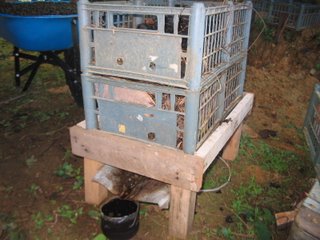WELCOME TO AGUABUENA


Aguabuena and Coopabuena are a ten minute walk away from each other seperated by the Rio Salto. This hill (which is a mountain if you look at it from the ocean on the other side) rises above Coopabuena to an altitude of over 4000 feet. Santa Cecilia and Santa Teresa are two villages higher up the mountain, Santa Teresa being at the top.

To the north and east of here are the volcanic Talamanca mountains that you can barely make out behind the clouds. These mountains are much higher, rising from 7-1200 ft. This is the home of the nearly inpenetrable cloud forests of Parque Amistad shared by both Panama and Costa Rica. The mountains in this picture are in Panama.
Now to our farm.

If you follow this road down long enough you will make it to our farm.
The Reforestation Nursery (still under progress)

This week I began the germination of our first seeds. I planted over 6000 seeds. The two seed beds down in the background are the beginnings of our seedling nursery. These two beds contain two different species of trees.
1. maria
Marias are a common canopy tree of this region. The wood is of medium hardness and considered very valuable for furniture making among other things. Because of this, many have been cut down in this region. These trees grow relatively fast. In this seedbed, I planted 1200 seeds. I cover them with banana leaves to protect the seedlings from excessive sun and as an attempt to stop too many weeds from growing.

2. nogal
Nogales are a Nicaraguan black walnut. They are not indeginous to this part of Costa Rica. They grow very fast. They are becoming increasingly popular among the campesinos here because the grow so fast. Since we our goal is to use only indeginous trees for our reforestation projects, we have some reservations about this tree, so I am only germinating 300 seeds. These are in the bed next to the marias.

3. danto
Dantos are an endangered tropical hardwood. The wood is extremely hard and is excellent wood for construction because of its extreme durablitiy although it is difficult to cut through. Many people in this region dont know of these trees, or have forgotten about them because of their scarcity. These trees prefer to grow above 1000 meters in riverbeds. Thus, they make a nearly perfect tree for our project. The only drawback of this tree is that it grows very slowly because the wood is so dense. In this picture I have 4-5000 seeds soaking in water before I plant them in the ground.

After these seeds sprout, I will put each in its own separte bag to grow for at least another 5 months. We plan on begining the transplantation project in a year, next April or May. Next month, I am going to return to Las Alturas de Coton to collect different species.
THE WORM FARM

Thomas, our friend from Michigan, is a worm farmer that sells his products in famers markets in the US. He taught us how to cultivate worms. This is the system:

Compost goes in each basket, and as the worms eat their favorites, their poop becomes excellent fertilizer. They slowly move up to the fresher bins, leaving behind enriched compost. We keep the environment wet for them, and the excess water drips down and we collect this worm juice "jugo de lombrisas".

This stuff is extremely potent.
MORE PHOTOS....

This area of the garage serves a double function as a carpentry table (built by Josh Mills) and a resting place to read, drink coffee and swing in the hammock.
Im going to end the picture show with this picture out our back window.

More to come
Eliot


